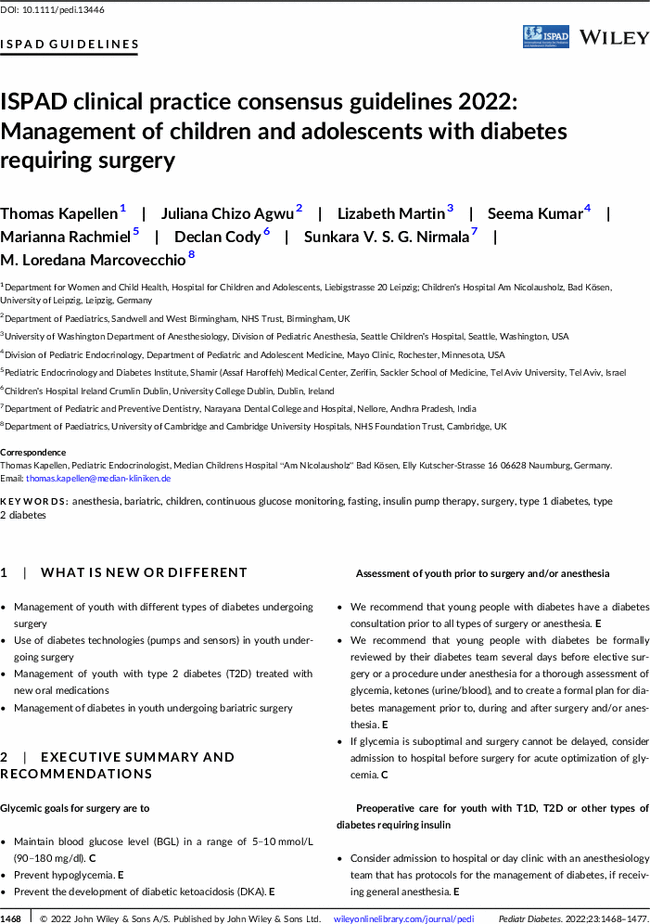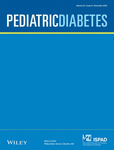ISPAD clinical practice consensus guidelines 2022: Management of children and adolescents with diabetes requiring surgery
Corresponding Author
Thomas Kapellen
Department for Women and Child Health, Hospital for Children and Adolescents, Liebigstrasse 20 Leipzig; Children's Hospital Am Nicolausholz, Bad Kösen, University of Leipzig, Leipzig, Germany
Correspondence
Thomas Kapellen, Pediatric Endocrinologist, Median Childrens Hospital “Am NIcolausholz” Bad Kösen, Elly Kutscher-Strasse 16 06628 Naumburg, Germany.
Email: [email protected]
Search for more papers by this authorJuliana Chizo Agwu
Department of Paediatrics, Sandwell and West Birmingham, NHS Trust, Birmingham, UK
Search for more papers by this authorLizabeth Martin
University of Washington Department of Anesthesiology, Division of Pediatric Anesthesia, Seattle Children's Hospital, Seattle, Washington, USA
Search for more papers by this authorSeema Kumar
Division of Pediatric Endocrinology, Department of Pediatric and Adolescent Medicine, Mayo Clinic, Rochester, Minnesota, USA
Search for more papers by this authorMarianna Rachmiel
Pediatric Endocrinology and Diabetes Institute, Shamir (Assaf Haroffeh) Medical Center, Zerifin, Sackler School of Medicine, Tel Aviv University, Tel Aviv, Israel
Search for more papers by this authorDeclan Cody
Children's Hospital Ireland Crumlin Dublin, University College Dublin, Dublin, Ireland
Search for more papers by this authorSunkara V. S. G. Nirmala
Department of Pediatric and Preventive Dentistry, Narayana Dental College and Hospital, Nellore, Andhra Pradesh, India
Search for more papers by this authorM. Loredana Marcovecchio
Department of Paediatrics, University of Cambridge and Cambridge University Hospitals, NHS Foundation Trust, Cambridge, UK
Search for more papers by this authorCorresponding Author
Thomas Kapellen
Department for Women and Child Health, Hospital for Children and Adolescents, Liebigstrasse 20 Leipzig; Children's Hospital Am Nicolausholz, Bad Kösen, University of Leipzig, Leipzig, Germany
Correspondence
Thomas Kapellen, Pediatric Endocrinologist, Median Childrens Hospital “Am NIcolausholz” Bad Kösen, Elly Kutscher-Strasse 16 06628 Naumburg, Germany.
Email: [email protected]
Search for more papers by this authorJuliana Chizo Agwu
Department of Paediatrics, Sandwell and West Birmingham, NHS Trust, Birmingham, UK
Search for more papers by this authorLizabeth Martin
University of Washington Department of Anesthesiology, Division of Pediatric Anesthesia, Seattle Children's Hospital, Seattle, Washington, USA
Search for more papers by this authorSeema Kumar
Division of Pediatric Endocrinology, Department of Pediatric and Adolescent Medicine, Mayo Clinic, Rochester, Minnesota, USA
Search for more papers by this authorMarianna Rachmiel
Pediatric Endocrinology and Diabetes Institute, Shamir (Assaf Haroffeh) Medical Center, Zerifin, Sackler School of Medicine, Tel Aviv University, Tel Aviv, Israel
Search for more papers by this authorDeclan Cody
Children's Hospital Ireland Crumlin Dublin, University College Dublin, Dublin, Ireland
Search for more papers by this authorSunkara V. S. G. Nirmala
Department of Pediatric and Preventive Dentistry, Narayana Dental College and Hospital, Nellore, Andhra Pradesh, India
Search for more papers by this authorM. Loredana Marcovecchio
Department of Paediatrics, University of Cambridge and Cambridge University Hospitals, NHS Foundation Trust, Cambridge, UK
Search for more papers by this author
CONFLICT OF INTEREST
The authors have declared no relevant conflicts of interest.
Open Research
DATA AVAILABILITY STATEMENT
Data sharing is not applicable to this article as no new data were created or analyzed in this study.
REFERENCES
- 1Jefferies C, Rhodes E, Rachmiel M, et al. ISPAD clinical practice consensus guidelines 2018: management of children and adolescents with diabetes requiring surgery. Pediatr Diabetes. 2018; 19(Suppl 27): 227-236. doi:10.1111/pedi.12733
- 2Craig METS, Donaghue KC, Cheung NW, et al. https://diabetessociety.com.au/documents/Type1guidelines14Nov2011.pdf
- 3Malcolm J, Halperin I, Miller DB, et al. In-Hospital Management of Diabetes. Can J Diabetes. 2018; 42(Suppl 1): S115-s123. doi:10.1016/j.jcjd.2017.10.014
- 4Agwu JCN, Ng SM, Edge JA, et al. Care of children under 18 years with diabetes mellitus undergoing surgery. http://www.a-c-d-c.org/wp-content/uploads/2012/08/Care-of-children-under-18-years-with-Diabetes-Mellitus-undergoing-Surgery-1.pdf
- 5Martin LD, Hoagland MA, Rhodes ET, Wolfsdorf JI, Hamrick JL, Society for Pediatric Anesthesia Quality and Safety Committee Diabetes Workgroup., Society for Pediatric Anesthesia Diabetes Workgroup members. Perioperative Management of Pediatric Patients with Type 1 diabetes mellitus, Updated Recommendations for Anesthesiologists. Anesth Analg. 2020; 130(4): 821-827. doi:10.1213/ANE.0000000000004491
- 6Jarvela KM, Khan NK, Loisa EL, Sutinen JA, Laurikka JO, Khan JA. Hyperglycemic episodes are associated with postoperative infections after cardiac surgery. Scand J Surg. 2018; 107(2): 138-144. doi:10.1177/1457496917731190
- 7Dronge AS, Perkal MF, Kancir S, Concato J, Aslan M, Rosenthal RA. Long-term glycemic control and postoperative infectious complications. Arch Surg. 2006; 141(4): 375-380; discussion 380. doi:10.1001/archsurg.141.4.375
- 8Cruse PJ, Foord R. A five-year prospective study of 23,649 surgical wounds. Arch Surg. 1973; 107(2): 206-210. doi:10.1001/archsurg.1973.01350200078018
- 9Guvener M, Pasaoglu I, Demircin M, Oc M. Perioperative hyperglycemia is a strong correlate of postoperative infection in type II diabetic patients after coronary artery bypass grafting. Endocr J. 2002; 49(5): 531-537. doi:10.1507/endocrj.49.531
- 10Farahani F, Ahn J, Nakonezny PA, Wukich DK, Wimberly RL, Riccio AI. Postoperative outcomes in diabetic pediatric Orthopaedic surgery patients: a National Database Study. J Pediatr Orthop. 2021; 41(8): e664-e670. doi:10.1097/BPO.0000000000001879
- 11Kaufman FR, Devgan S, Roe TF, Costin G. Perioperative management with prolonged intravenous insulin infusion versus subcutaneous insulin in children with type I diabetes mellitus. J Diabetes Complications. 1996; 10(1): 6-11. doi:10.1016/1056-8727(94)00044-1
- 12van den Berghe G, Wouters P, Weekers F, et al. Intensive insulin therapy in critically ill patients. N Engl J Med. 2001; 345(19): 1359-1367. doi:10.1056/NEJMoa011300
- 13Finfer S, Chittock D, Li Y, et al. Intensive versus conventional glucose control in critically ill patients with traumatic brain injury: long-term follow-up of a subgroup of patients from the NICE-SUGAR study. Intensive Care Med. 2015; 41(6): 1037-1047. doi:10.1007/s00134-015-3757-6
- 14Intensive versus conventional glucose control in critically ill patients. New England Journal of Medicine. 2009; 360(13): 1283-1297. doi:10.1056/NEJMoa0810625
- 15Kao LS, Meeks D, Moyer VA, Lally KP. Peri-operative glycaemic control regimens for preventing surgical site infections in adults. Cochrane Database Syst Rev. 2009; 8(3): CD006806. doi:10.1002/14651858.CD006806.pub2
- 16Doenst T, Wijeysundera D, Karkouti K, et al. Hyperglycemia during cardiopulmonary bypass is an independent risk factor for mortality in patients undergoing cardiac surgery. J Thorac Cardiovasc Surg. 2005; 130(4): 1144-1144.e8. doi:10.1016/j.jtcvs.2005.05.049
- 17Ata A, Valerian BT, Lee EC, Bestle SL, Elmendorf SL, Stain SC. The effect of diabetes mellitus on surgical site infections after colorectal and noncolorectal general surgical operations. Am Surg. 2010; 76(7): 697-702.
- 18Zerr KJ, Furnary AP, Grunkemeier GL, Bookin S, Kanhere V, Starr A. Glucose control lowers the risk of wound infection in diabetics after open heart operations. Ann Thorac Surg. 1997; 63(2): 356-361. doi:10.1016/s0003-4975(96)01044-2
- 19Buchleitner AM, Martinez-Alonso M, Hernandez M, Sola I, Mauricio D. Perioperative glycaemic control for diabetic patients undergoing surgery. Cochrane Database Syst Rev. 2012; 12(9): CD007315. doi:10.1002/14651858.CD007315.pub2
- 20Krinsley JS, Schultz MJ, Spronk PE, et al. Mild hypoglycemia is independently associated with increased mortality in the critically ill. Crit Care. 2011; 15(4): R173. doi:10.1186/cc10322 R173.
- 21Adler GK, Bonyhay I, Failing H, Waring E, Dotson S, Freeman R. Antecedent hypoglycemia impairs autonomic cardiovascular function: implications for rigorous glycemic control. Diabetes. 2009; 58(2): 360-366. doi:10.2337/db08-1153
- 22Martin-Timon I, Del Canizo-Gomez FJ. Mechanisms of hypoglycemia unawareness and implications in diabetic patients. World J Diabetes. 2015; 6(7): 912-926. doi:10.4239/wjd.v6.i7.912
- 23Faustino EV, Apkon M. Persistent hyperglycemia in critically ill children. J Pediatr. 2005; 146(1): 30-34. doi:10.1016/j.jpeds.2004.08.076
- 24Faustino EV, Bogue CW. Relationship between hypoglycemia and mortality in critically ill children. Pediatr Crit Care Med. 2010; 11(6): 690-698. doi:10.1097/PCC.0b013e3181e8f502
- 25Kong MY, Alten J, Tofil N. Is hyperglycemia really harmful? A critical appraisal of "persistent hyperglycemia in critically ill children" by Faustino and Apkon (J Pediatr 2005; 146:30-34). Pediatr Crit Care Med. 2007; 8(5): 482-485. doi:10.1097/01.PCC.0000282778.86088.9D
- 26Hirshberg E, Larsen G, Van Duker H. Alterations in glucose homeostasis in the pediatric intensive care unit: hyperglycemia and glucose variability are associated with increased mortality and morbidity. Pediatr Crit Care Med. 2008; 9(4): 361-366. doi:10.1097/PCC.0b013e318172d401
- 27Agus MS. Tight glycemic control in children--is the target in sight? N Engl J Med. 2014; 370(2): 168-169. doi:10.1056/NEJMe1313770
- 28Agus MS, Asaro LA, Steil GM, et al. Tight glycemic control after pediatric cardiac surgery in high-risk patient populations: a secondary analysis of the safe pediatric euglycemia after cardiac surgery trial. Circulation. 2014; 129(22): 2297-2304. doi:10.1161/CIRCULATIONAHA.113.008124
- 29Srinivasan V, Agus MS. Tight glucose control in critically ill children--a systematic review and meta-analysis. Pediatr Diabetes. 2014; 15(2): 75-83. doi:10.1111/pedi.12134
- 30Jeschke MG, Kraft R, Emdad F, Kulp GA, Williams FN, Herndon DN. Glucose control in severely thermally injured pediatric patients: what glucose range should be the target? Ann Surg. 2010; 252(3): 521-527; discussion 527–8, 528. doi:10.1097/SLA.0b013e3181f2774c
- 31Macrae D, Grieve R, Allen E, et al. A randomized trial of hyperglycemic control in pediatric intensive care. N Engl J Med. 2014; 370(2): 107-118. doi:10.1056/NEJMoa1302564
- 32Vlasselaers D, Milants I, Desmet L, et al. Intensive insulin therapy for patients in paediatric intensive care: a prospective, randomised controlled study. Lancet. 2009; 373(9663): 547-556. doi:10.1016/S0140-6736(09)60044-1
- 33Ling Y, Li X, Gao X. Intensive versus conventional glucose control in critically ill patients: a meta-analysis of randomized controlled trials. Eur J Intern Med. 2012; 23(6): 564-574. doi:10.1016/j.ejim.2012.02.013
- 34Agus MS, Wypij D, Hirshberg EL, et al. Tight glycemic control in critically ill children. The New England Journal of Medicine. 2017; 376(8): 729-741. doi:10.1056/NEJMoa1612348
- 35Draznin B, Aroda VR, Bakris G, et al. 16. Diabetes Care in the Hospital: standards of medical Care in Diabetes-2022. Diabetes Care. 2022; 45(Suppl 1): S244-s253. doi:10.2337/dc22-S016
- 36Piper HG, Alexander JL, Shukla A, et al. Real-time continuous glucose monitoring in pediatric patients during and after cardiac surgery. Pediatrics. 2006; 118(3): 1176-1184. doi:10.1542/peds.2006-0347
- 37Tripyla A, Herzig D, Joachim D, et al. Performance of a factory-calibrated, real-time continuous glucose monitoring system during elective abdominal surgery. Diabetes Obes Metab. 2020; 22(9): 1678-1682. doi:10.1111/dom.14073
- 38Olafsdottir AF, Attvall S, Sandgren U, et al. A clinical trial of the accuracy and treatment experience of the flash glucose monitor FreeStyle libre in adults with type 1 diabetes. Diabetes Technol Ther. 2017; 19(3): 164-172. doi:10.1089/dia.2016.0392
- 39Ancona P, Eastwood GM, Lucchetta L, Ekinci EI, Bellomo R, Martensson J. The performance of flash glucose monitoring in critically ill patients with diabetes. Crit Care Resusc. 2017; 19(2): 167-174.
- 40Maahs DM, DeSalvo D, Pyle L, et al. Effect of acetaminophen on CGM glucose in an outpatient setting. Diabetes Care. 2015; 38(10): e158-e159. doi:10.2337/dc15-1096
- 41Basu A, Slama MQ, Nicholson WT, et al. Continuous glucose monitor interference with commonly prescribed medications: a pilot study. J Diabetes Sci Technol. 2017; 11(5): 936-941. doi:10.1177/1932296817697329
- 42Tellez SE, Hornung LN, Courter JD, et al. Inaccurate glucose sensor values after Hydroxyurea administration. Diabetes Technol Ther. 2021; 23(6): 443-451. doi:10.1089/dia.2020.0490
- 43Demma LJ, Carlson KT, Duggan EW, Morrow JG 3rd, Umpierrez G. Effect of basal insulin dosage on blood glucose concentration in ambulatory surgery patients with type 2 diabetes. J Clin Anesth. 2017; 36: 184-188. doi:10.1016/j.jclinane.2016.10.003
- 44Mucha GT, Merkel S, Thomas W, Bantle JP. Fasting and insulin glargine in individuals with type 1 diabetes. Diabetes Care. 2004; 27(5): 1209-1210.
- 45Al-Khawari M, Al-Ruwayeh A, Al-Doub K, Allgrove J. Adolescents on basal-bolus insulin can fast during Ramadan. Pediatr Diabetes. 2010; 11(2): 96-100. doi:10.1111/j.1399-5448.2009.00544.x
- 46Baradari AG, Emami Zeydi A, Aarabi M, Ghafari R. Metformin as an adjunct to insulin for glycemic control in patients with type 2 diabetes after CABG surgery: a randomized double blind clinical trial. Pak J Biol Sci. 2011; 14(23): 1047-1054. doi:10.3923/pjbs.2011.1047.1054
- 47Baradari AG, Habibi MR, Khezri HD, et al. Does high-dose metformin cause lactic acidosis in type 2 diabetic patients after CABG surgery? A double blind randomized clinical trial. Heart Int. 2011; 6(1):e8. doi:10.4081/hi.2011.e8
- 48Chumakova-Orin M, Vanetta C, Moris DP, Guerron AD. Diabetes remission after bariatric surgery. World J Diabetes. 2021; 12(7): 1093-1101. doi:10.4239/wjd.v12.i7.1093




